The US government recently announced that it was lifting its moratorium on funding certain experiments that use human stem cells to create animals that are partly human. At present scientists are only interested in creating entities with some human qualities, but which remain “mostly” animals. For example, some scientists want to create a chimeric pig with a human-enough heart to transplant into a human. Distinguishing between humans and other animals is common in most cultures.
The post Human-animal chimeras and dehumanization appeared first on OUPblog.
Deborah Hopkinson is the award-winning author of more than 45 books for young readers.
I know, I know, I promised you interviews on Tuesdays and here I come with a book review. This is a book of passion and courage; a book championing, as I often do on my blog, the rights of other … Continue reading →
Should we eat animals? Vegetarians often say “No, because the meat industry harms animals greatly.” They point to the appalling conditions in which animals are raised in factory farms, and the manner in which they are killed. Meat-eaters often reply that this objection is ill-founded because animals owe their very existence to the meat industry.
The post Does the meat industry harm animals? appeared first on OUPblog.
The introduction for Untamed: The Wild Life of Jane Goodall by Anita Silvey begins by noting that Jane Goodall "has been chosen as the most recognized scientist in the Western world." Regardless of how accurate that statement is, the fact remains that Jane Goodall is still alive, has been working in her field for over 50 years and her subject is something that is almost universally appealing
A Boy and a Jaguar, illustrated by Cátia Chien, is the moving memoir by Alan Rabinowitz of his childhood love of animals and the stuttering that shaped him and informed his life as an adult. Rabinowitz's story is told in an elegantly simple style and has an element of the almost-magical that reads like a fairy tale and Chien's illustrations, sometimes hazy and moody, sometimes brightly
Ivan: The Remarkable True Story of the Shopping Mall Gorilla by Katherine ApplegateG. Brian Karas is an invaluable addition to the shelves and ideal companion to Applegate's 2013 Newbery Gold Medal winner, The One and Only Ivan. Written in free verse, The One and Only Ivan is one of a handful of Newbery winners that can be read and understood by younger readers, which is especially nice. Now,
By Lori Gruen
The decision by the administrators of the Copenhagen Zoo to kill a two-year-old giraffe named Marius by shooting him in the head in February 2014, then autopsy his body in public and feed Marius’ body parts to the lions held captive at the zoo created quite an uproar. When the same zoo then killed the lions (an adult pair and their two cubs) a month later to make room for a more genetically-worthy captive, the uproar became more ferocious.
Animal lovers across the globe were shocked and sickened by these killings and couldn’t understand why this bloodshed was being carried out at a zoo.
The zoo’s justification for killing Marius was that he had genes that were already “well represented” in the captive giraffe population in Europe. The justification for killing the lions was that the zoo was planning to introduce a younger male who was not genetically related to any of the females in the group.
Sacrificing the well-being and even the lives of individual animals in the name of conserving a diverse gene pool is commonplace in zoos. Euthanasia, usually by means less grotesque than a shotgun to the head, is quite common in European zoos. In US zoos, contraception is often used to prevent “over-representation” of certain gene lines. The European zoos’ reason for not using birth control the way most American zoos do is that they believe allowing animals to reproduce provides the animals with the opportunity to engage the fuller range of species typical behaviors, but that also means killing the undesirable offspring. In both European and US zoos, families are broken up and individuals are shipped to other facilities to diversify and manage the captive gene pool.
If this all has a ring of eugenic reasoning, consider what the executive director of the World Association of Zoos and Aquariums, Gerald Dick, had to say: “In Europe, there is a strict attempt to maintain genetically pure animals and not waste space in a zoo for genetically useless specimens.”
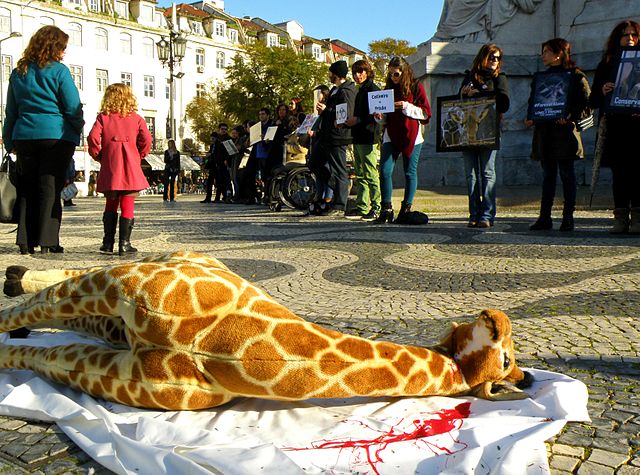
A stuffed giraffe, representing Marius, at a protest against zoos and the confinement of animals in Lisbon, 2014
The high-profile slaughter of Marius and the lions that ate his body focus attention on an important debate about the purpose of zoos and more generally the ethics of captivity. Originally, zoos were designed to amuse, amaze, and entertain visitors. As public awareness of the plight of endangered species and their diminishing habitats grew, zoos increasingly saw their roles as conservation and education. But just what is being conserved and what are the educational lessons that zoo-goers take away from their experiences at the zoo?
A recent study suggests that zoo-goers learn about biodiversity by visiting zoos. Critics have suggested that the study is not particularly convincing in linking the small increase in understanding of biodiversity with the complex demands of conservation. Some zoos are committed to direct conservation efforts; the Wildlife Conservation Society (aka the Bronx Zoo) and the Lincoln Park Zoo are just two examples of zoos that have extensive and successful conservation programs. Despite these laudable programs, these WAZA-accredited zoos, like the European zoos, are also in the business of gene management and a central tenet of the current management ethos is to value genetic diversity over individual well-being.
Awe-inspiring animals such as giraffes and gorillas and cheetahs and chimpanzees are not seen as individuals, with distinct perspectives, when viewed, as Dick says, as either useful or useless “specimens.” They are valued, if at all, as representative carriers of their species’ genes.
This distorts our understanding of other animals and our relationships to them. Part of the problem is that zoos are not places in which animals can be seen as dignified. Zoos are designed to satisfy human interests and desires, even though they largely fail at this. A trip to the zoo creates a relationship in which the observer, often a child, has a feeling of dominant distance over the animals being looked at. It is hard to respect and admire a being that is captive in every respect and viewed as a disposable specimen, one who can be killed to satisfy a mission that is hard for the zoo-going public to fully understand, let alone endorse.
Causing death is what zoos do. It is not all that they do, but it is a big part of what happens at zoos, even if this is usually hidden from the public. Zoos are institutions that not only purposely kill animals, they are also places that in holding certain animals captive, shorten their lives. Some animals, such as elephants and orca whales, cannot thrive in captivity and holding them in zoos and aquaria causes them to die prematurely.
Death is a natural part of life, and perhaps we would do well to have a less fearful, more accepting attitude about death. But those who purposefully bring about premature death run the risk of perpetuating the notion that some lives are disposable. It is that very idea that we can use and dispose of other animals as we please that has led to the problems that have zoos and others thinking about conservation in the first place. When institutions of captivity promote the idea that some animals are disposable by killing “genetically useless specimens” like young Marius and the lions, they may very well be undermining the tenuous conservation claims that are meant to justify their existence.
Lori Gruen is Professor of Philosophy, Feminist, Gender, and Sexuality Studies, and Environmental Studies at Wesleyan University where she also coordinates Wesleyan Animal Studies and directs the Ethics in Society Project. She is the author of The Ethics of Captivity.
Subscribe to the OUPblog via email or RSS.
Subscribe to only philosophy articles on the OUPblog via email or RSS.
Image credit: Sit-in protest in Lisbon. Photo by Mattia Luigi Nappi, 2014. CC-BY-SA-3.0 via Wikimedia Commons
The post Disposable captives appeared first on OUPblog.

** January 23, 2013: A report from a National Institute of Health council unanimously recommended that almost ALL of the 451 chimpanzees currently housed at their facilities for the purposes of research and testing be retired, as reported by James Gorman in the New York Times yesterday. Sadly, the N.I.H does not have the funds to retire some 400 of the chimps OR enact the changes to the
Tua and the Elephant is a beautiful, delightful little book set in Thailand about a girl and an elephant by RP Harris with marvelous illustrations by Taeeun Yoo. Aptly, Sara Gruen, author of the adult novel Like Water for Elephants, wrote a great review of Tua and the Elephant that ran in the New York Times Book Review in May. The prologue of Tua and the Elephant tells us that "when Tua was
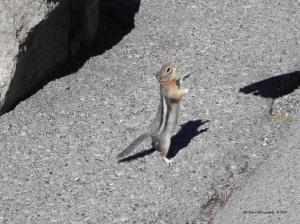 Today’s poem challenge is to write about an animal, addressing any aspect desired. Okay, I can do that. Like most people I’m fond of animals. They serve so many purposes within our lives that to have a world devoid of them seems sacrilegious.
Today’s poem challenge is to write about an animal, addressing any aspect desired. Okay, I can do that. Like most people I’m fond of animals. They serve so many purposes within our lives that to have a world devoid of them seems sacrilegious.
Growing up in the country guaranteed that I knew and appreciated the roles of animals in our daily lives. So many years later, I still consider them the gifts of the earth, put on loan to us; teachers to teach us how to be guardians. You can decide for yourselves if we’ve ever learned the lessons.
Some creatures inhabit our dwellings as friends and family members. Others enrich our lives with their colors, textures, uniqueness, and myriad dimensions. The poems I’ve done today for this challenge are from both sides of the animal question; in house and outside it.
As always, I hope you enjoy these small efforts of mine. Take the time to comment; share some of your animal tales with others, if you wish. Above all, take a good look at what your life would be like without the non-human inhabitants in your life.
Companion Truth
Brandy orbs trusting, I see
Filled with love looking at me,
Gentle power of loyalty
Ever near, ever dear sentry.
Raise the call with nose held high
Licker of feet for miles gone by,
Pass this way my care to enjoy
Walk at heel my life an envoy.
© Claudette J. Young 2012
Vixen’s Siren
Screams fill the night,
Terrorizing the listener.
Finger hovers over 911,
Until reason asserts truth.
It’s spring;
Her annual mating ritual begins
With blood-chilling siren song,
Seeking company for the nonce,
The vixen readies to entertain.
© Claudette Young 2012
Related articles



 2 Comments on PAD Day 26—Fur, Fowl and Animal Poems, last added: 4/29/2012
2 Comments on PAD Day 26—Fur, Fowl and Animal Poems, last added: 4/29/2012






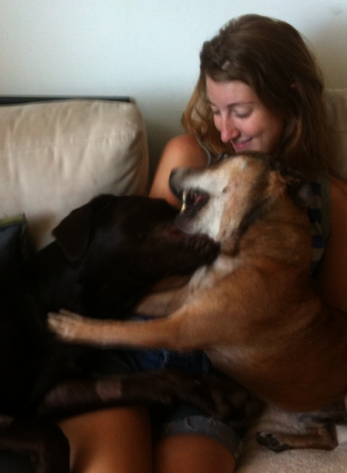
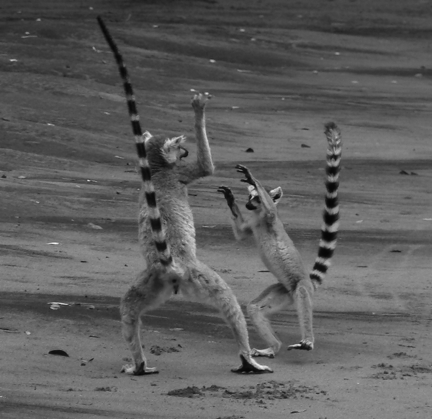 0 Comments on Friday Pet Blogging: Bentley as of 1/1/1900
0 Comments on Friday Pet Blogging: Bentley as of 1/1/1900

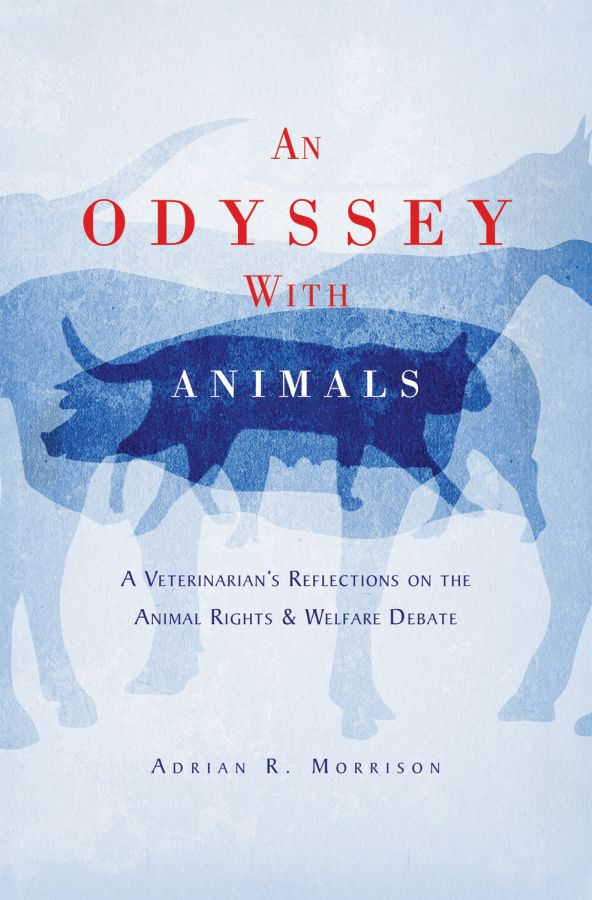

Dear Tanya,<br /><br />I get a Google Alert when one of my books is mentioned, or my name, so that's how I saw your review of Hurt Go Happy.<br /><br />I'm in tears. Your review of HGH was the most beautiful I've read since it came out in 2006. You might not know this, but from conception to publication took 18 years. Three of those years it was on the top shelf of the closet in my
Beautiful review! Beautiful book!
Thank you! Thank you! I'm honored if I conveyed even a fraction of how important and amazing HURT GO HAPPY is.
Beautiful review and equally wonderful story.
Thank you for reading, and for your kind words. I hope that there is a peaceful, happy ending for the real chimps used for research purposes at the NIH, just like Sukari's brief but happy ending.